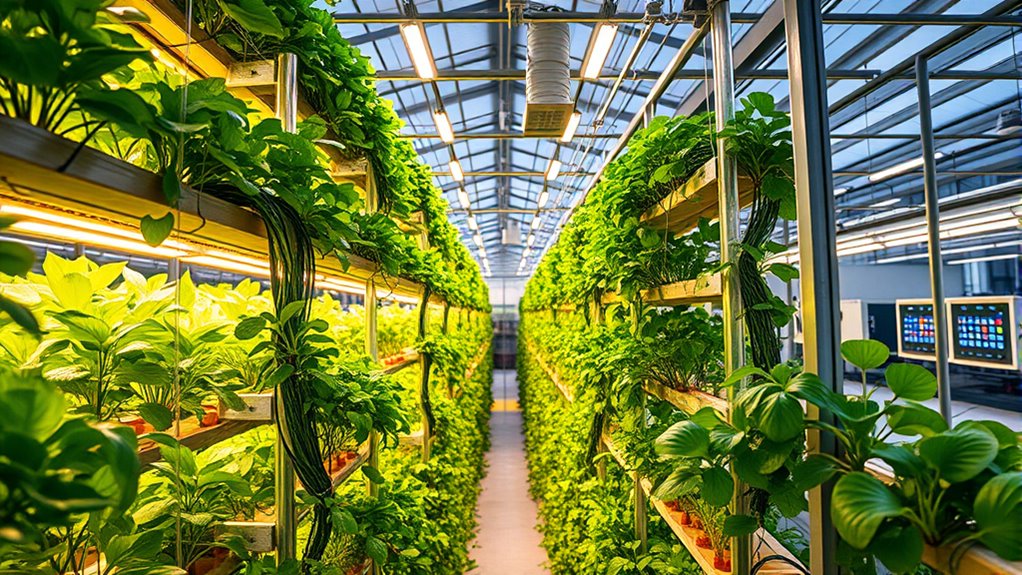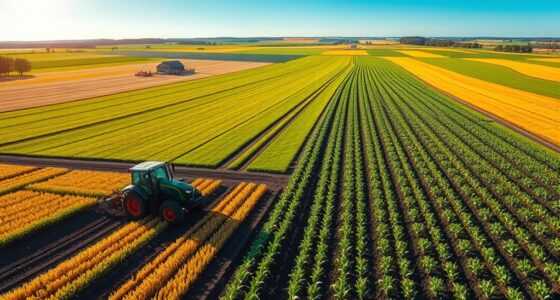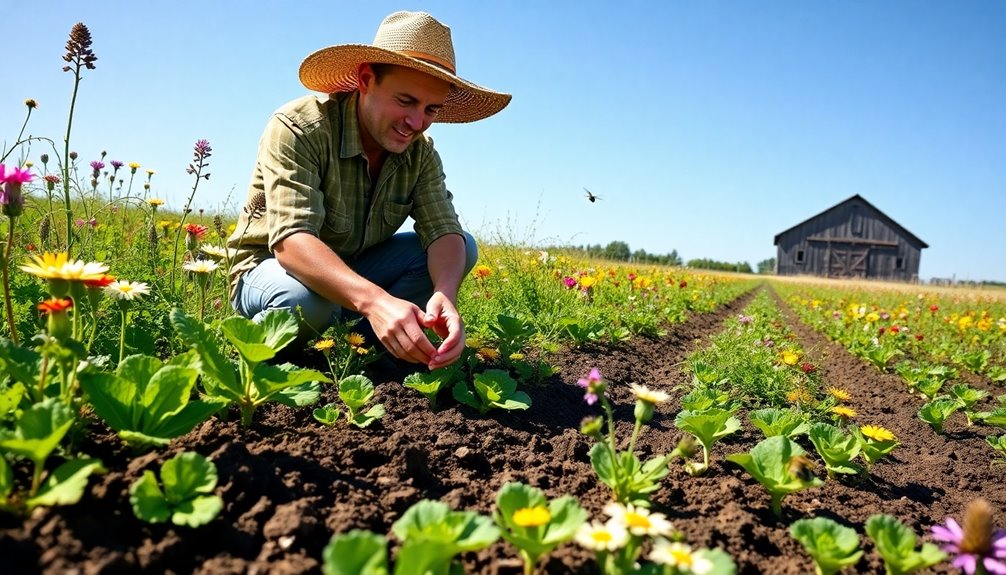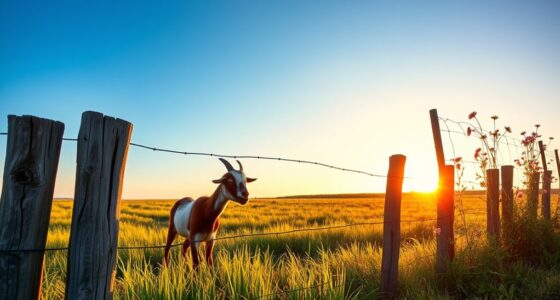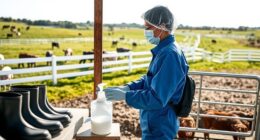Controlled-environment agriculture (CEA) uses technology to grow food indoors, including vertical farms and greenhouses that optimize temperature, humidity, light, and CO₂ levels. These systems allow year-round production, conserve resources, and reduce pests and environmental impact. Vertical farms maximize space with stacked layers, while greenhouses use advanced glazing and climate control to boost yields. To explore how these innovations transform farming and sustainability, continue exploring the latest advancements and benefits.
Key Takeaways
- Controlled-environment agriculture (CEA) uses sensors, automation, and AI to optimize conditions for year-round crop production in vertical farms and greenhouses.
- Vertical farms maximize space efficiency through stacked layers, hydroponics, and aeroponics, suitable for limited urban areas.
- Greenhouses utilize advanced insulation, glazing, and climate control systems to regulate temperature, humidity, and light for optimal growth.
- CEA reduces resource waste by recycling water, precise nutrient delivery, and energy-efficient lighting, supporting sustainability goals.
- High startup costs and energy consumption are challenges, but technological advances and market demand drive growth in this industry.
Understanding Controlled-Environment Agriculture
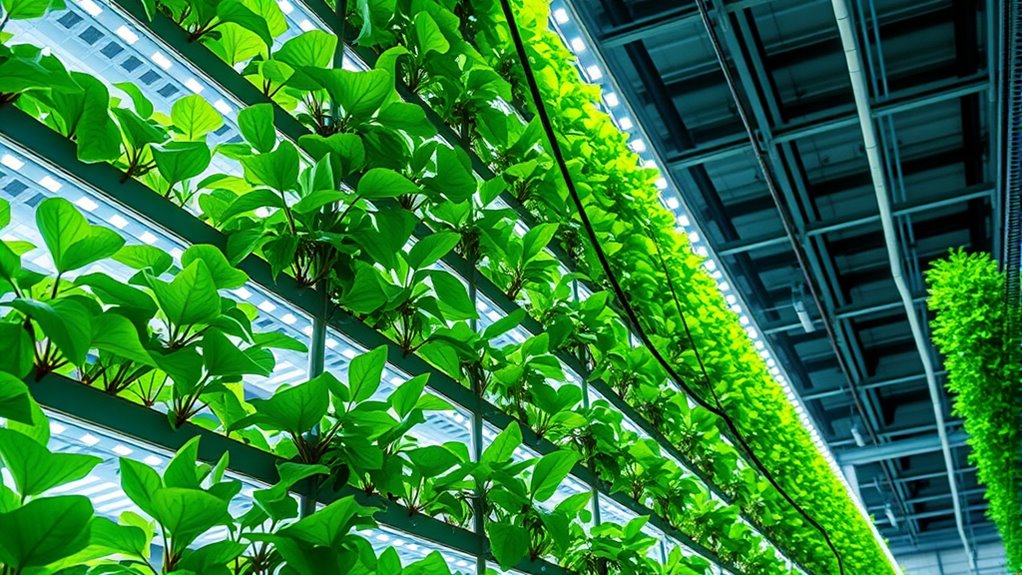
Controlled-environment agriculture (CEA) refers to the practice of growing plants within a setting where key environmental factors are carefully managed. You control variables like temperature, humidity, light, and CO₂ levels to optimize plant growth. This precise management allows you to produce crops year-round, regardless of external weather conditions. CEA systems often use technology such as sensors and automation to maintain ideal conditions, reducing resource waste. By creating a stable environment, you minimize pests and diseases, decreasing the need for chemical interventions. This approach enhances crop yields and quality while conserving water and nutrients. Fundamentally, CEA gives you the ability to grow food more efficiently and sustainably, making it a crucial solution for modern agriculture challenges. Efficient resource management plays a vital role in maximizing the benefits of controlled-environment agriculture.
Types of Vertical Farming Systems
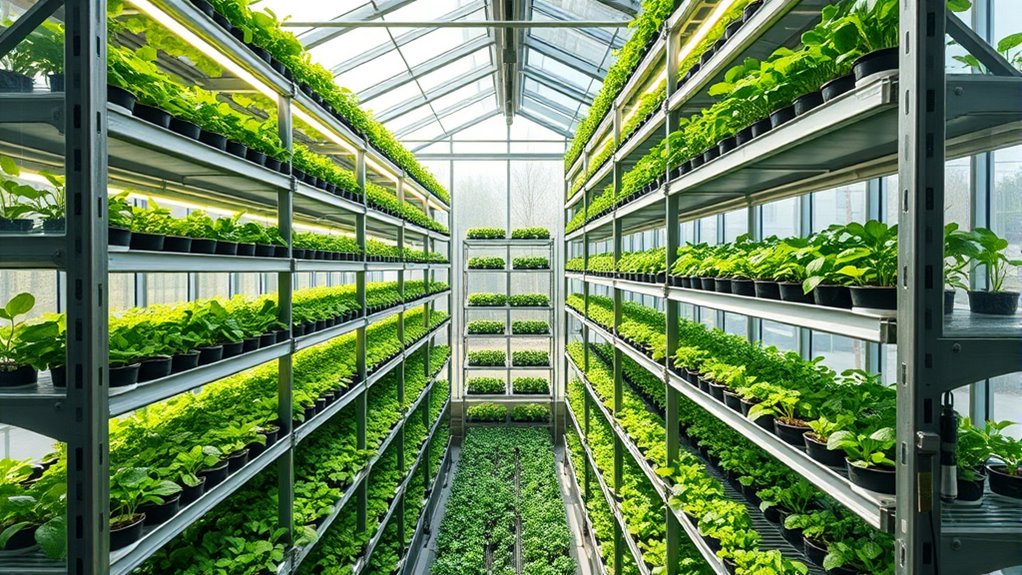
Vertical farming systems come in several distinct types, each designed to maximize space efficiency and enhance growing conditions within a controlled environment. You’ll find stacked layer systems, where plants grow on multiple tiers, making the most of limited space. Aeroponics involves suspending roots in the air and misting them with nutrient solutions, reducing water use and promoting faster growth. Hydroponic systems grow plants in nutrient-rich water without soil, offering precise control over nutrients and minimizing pests. Vertical towers use rotating or stationary columns to cultivate leafy greens and herbs efficiently. Each system caters to specific crops and operational goals, allowing you to tailor your approach based on available space, crop type, and resource management. Selecting the appropriate system can also benefit from market growth insights, as technological advancements continue to expand options for efficient urban agriculture. Each choice helps maximize yield while maintaining ideal environmental conditions.
Greenhouse Technologies and Design

Greenhouse technologies and design focus on creating ideal growing conditions by integrating advanced structures and systems. You’ll find that modern greenhouses use insulation, shading, and ventilation to regulate temperature and humidity efficiently. Automated climate control systems monitor and adjust airflow, heating, and cooling, ensuring best environments for plants. Advanced glazing materials, like double-pane or UV-resistant glass, maximize light transmission while reducing energy loss. You might also incorporate hydroponic or aeroponic systems within the greenhouse to maximize water and nutrient delivery. Structural designs often include adjustable vents and roll-up sides to promote natural airflow. With these innovations, you can maintain consistent conditions, improve crop yields, and extend growing seasons, all while minimizing energy consumption and environmental impact. Enhanced climate control systems further optimize growing conditions by precisely adjusting environmental parameters in real-time.
Benefits of Indoor and Controlled-Environment Farming
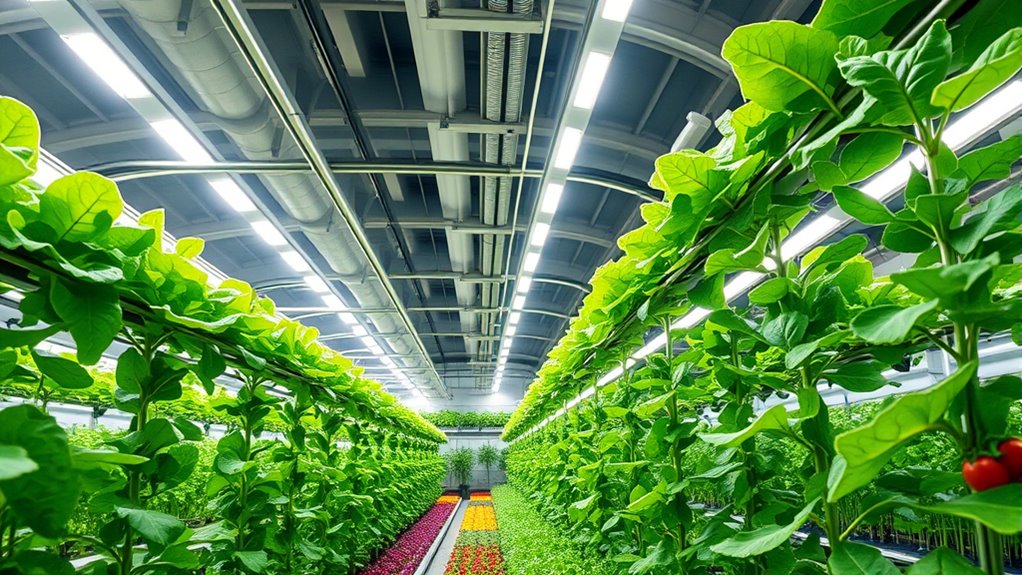
Indoor and controlled-environment farming offer numerous advantages, especially in regions with limited arable land or unpredictable weather. By controlling temperature, humidity, and light, you can optimize growing conditions year-round, leading to faster crop cycles and higher yields. This method reduces the risk of pests and diseases, minimizing the need for pesticides and chemicals. You also gain the ability to grow fresh produce locally, cutting down on transportation costs and carbon footprint. Additionally, controlled environments conserve water through recycling and precise delivery, making your farming more sustainable. This approach allows you to grow a variety of crops in small spaces, increasing your productivity regardless of external climate challenges. Incorporating high-quality projectors can enhance monitoring and management of indoor farms, ensuring optimal conditions at all times. Overall, indoor and controlled-environment farming offers a reliable, efficient way to produce food sustainably.
Challenges and Limitations of Vertical Farms and Greenhouses
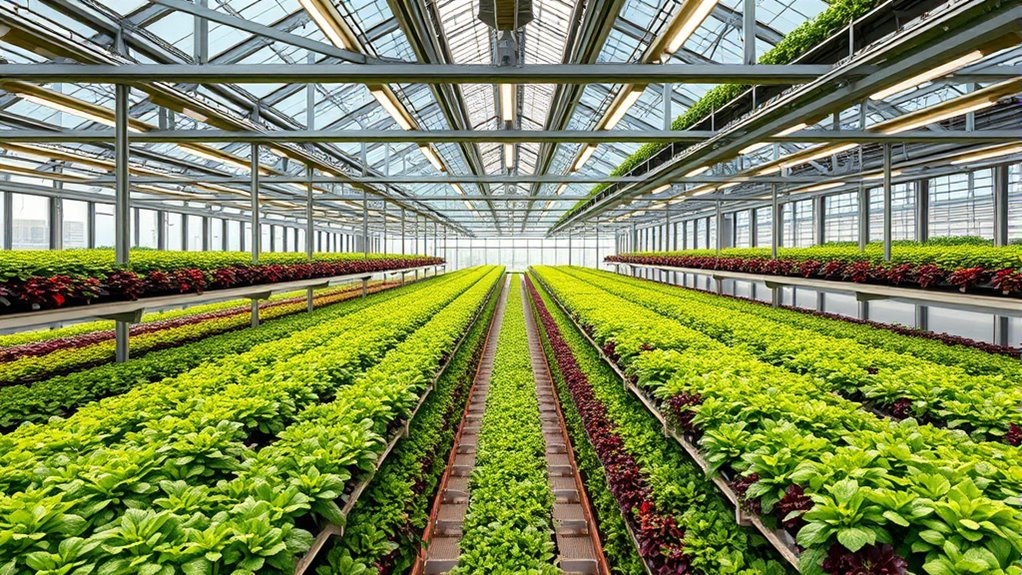
Despite their many advantages, vertical farms and greenhouses face significant challenges that can limit their practicality and widespread adoption. High startup costs are a major hurdle, requiring substantial investments in specialized equipment, lighting, and climate control systems. Energy consumption is another concern, as maintaining ideal conditions demands significant power, impacting both costs and sustainability. Additionally, technical complexity can pose difficulties for operators, requiring expertise in managing environmental systems. Limited crop variety and scale also restrict profitability for some growers. Furthermore, local regulations and zoning laws may impede development in certain areas. These challenges mean that, while innovative, vertical farms and greenhouses currently face economic and logistical barriers that slow their broader implementation. Moreover, energy-intensive climate control remains a significant factor affecting their sustainability and operational costs.
Innovations in Climate Control and Automation
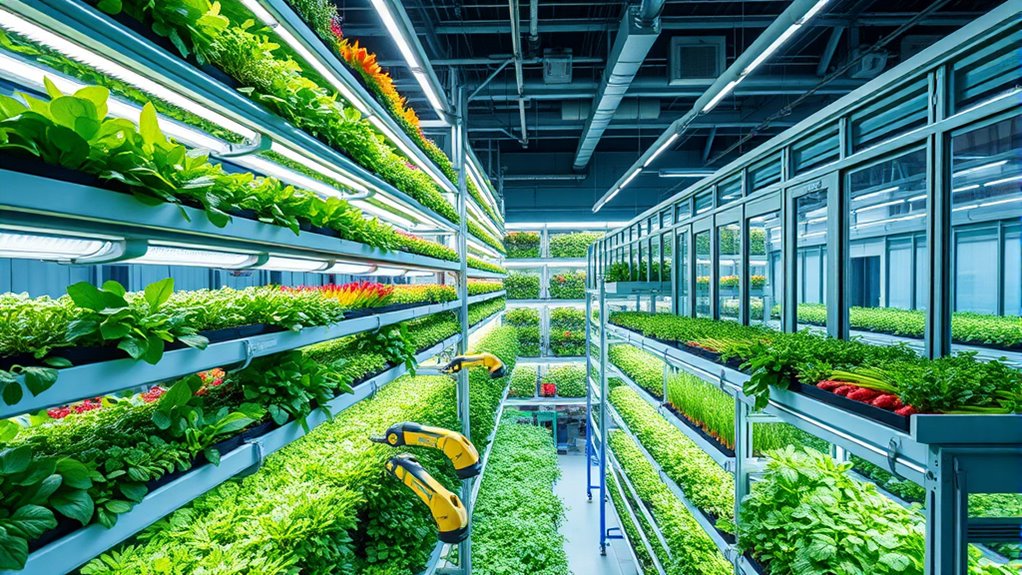
Advancements in climate control and automation are transforming how controlled-environment agriculture operates, making it more efficient and sustainable. You now benefit from smart systems that precisely regulate temperature, humidity, and CO₂ levels, optimizing plant growth conditions in real time. Automated sensors continuously monitor environmental parameters, reducing manual intervention and errors. Machine learning algorithms analyze data to predict and adjust conditions proactively, improving crop yields. Additionally, automation streamlines operations, saving labor costs and increasing consistency. These innovations also enable remote management, giving you greater flexibility and control over your farm.
Climate control automation enhances efficiency, sustainability, and remote management in controlled-environment agriculture.
- Integration of IoT sensors for real-time environmental monitoring
- AI-driven systems for predictive climate adjustments
- Automated irrigation and nutrient delivery
- Advanced ventilation and shading controls
- Data analytics for ongoing system optimization
Enhanced safety features in modern climate control systems further ensure reliable operation and protect your crops from potential hazards.
Sustainability and Resource Efficiency

How can controlled-environment agriculture minimize resource use while maximizing productivity? By optimizing water, energy, and nutrient inputs, you reduce waste and environmental impact. Techniques like recirculating hydroponics and LED lighting cut water and power consumption. Precise climate control minimizes energy use and prevents crop loss. Here’s how resource efficiency improves:
| Resource | Benefit |
|---|---|
| Water | Recycling reduces total consumption |
| Energy | Efficient lighting and automation lower usage |
| Nutrients | Targeted delivery prevents waste |
| Space | Vertical farming maximizes yield per square foot |
This approach ensures sustainable, high-yield food production while conserving essential resources. Additionally, implementing climate control systems can further optimize environmental conditions and improve overall efficiency.
Economic Considerations and Market Potential

Understanding the investment and operational costs helps you assess whether controlled-environment agriculture is financially viable. You should also consider current market demand and growth potential to determine if your efforts will meet consumer needs. By analyzing these factors, you can better identify opportunities for profitability and expansion. Additionally, being aware of regulatory compliance challenges ensures your practices adhere to legal standards and avoid costly penalties.
Investment and Operational Costs
Investing in controlled-environment agriculture (CEA) requires significant upfront capital for infrastructure, technology, and systems setup, but these costs are often offset by lower long-term operational expenses and higher yields. You’ll need to budget for lighting, climate control, automation, and building materials, which can be substantial initially. However, operational costs tend to decrease over time due to resource efficiency and optimized processes. Contemplate factors like energy consumption, maintenance, and labor, which influence ongoing expenses. Proper planning can help maximize return on investment. To enhance your understanding, here are key points to consider:
- Initial capital requirements and funding options
- Cost-saving opportunities through energy efficiency
- Impact of automation on labor costs
- Maintenance and system upgrade expenses
- Long-term financial benefits versus upfront investments
Market potential is a significant factor influencing the overall profitability of CEA projects.
Market Demand and Growth
Are you aware of the rapidly expanding market for controlled-environment agriculture (CEA)? This growth is driven by increasing consumer demand for fresh, local, and sustainably produced food. Urbanization and limited arable land make CEA solutions like vertical farms and greenhouses more attractive, promising year-round production regardless of climate. Investors recognize the potential for high returns due to the scalability and efficiency of these systems. Market forecasts project significant growth over the next decade, with global value expected to reach billions of dollars. As awareness of environmental issues rises, so does the willingness to support innovative farming methods. This trend indicates a lucrative opportunity for entrepreneurs and established companies to capitalize on the increasing demand for fresh, healthy produce. Additionally, advancements in agricultural technology are continuously improving yield efficiency and resource management, further fueling industry growth.
Future Trends and Developments in Controlled-Environment Agriculture
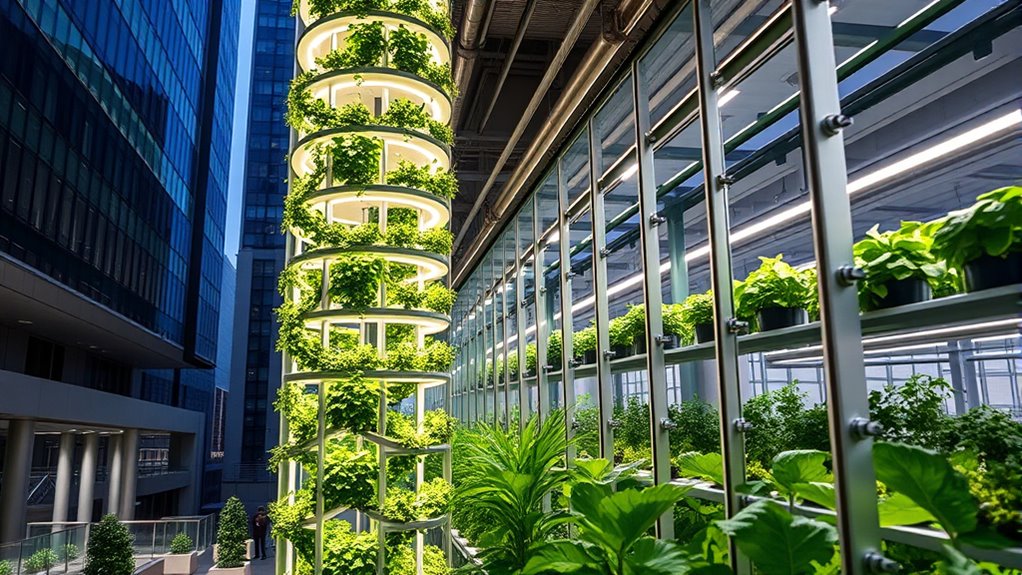
What innovations will shape the future of controlled-environment agriculture? As technology advances, you’ll see smarter systems transforming how we grow food. Expect increased integration of AI and machine learning to optimize resource use and crop yields. Vertical farms will become more energy-efficient, utilizing renewable sources and advanced lighting. Automation will streamline planting, harvesting, and maintenance, reducing labor costs. Additionally, biotechnology will enable crops to thrive in diverse environments, expanding urban farming possibilities. Precision sensors and data analytics will provide real-time insights, enhancing decision-making. Ultimately, modular and scalable setups will allow rapid deployment in various locations, making CEA more accessible and adaptable. These developments will create a more sustainable, resilient, and productive future for controlled-environment agriculture.
Frequently Asked Questions
How Do Vertical Farms Impact Local Ecosystems and Biodiversity?
Vertical farms can positively impact local ecosystems and biodiversity by reducing the need for land clearing and minimizing habitat destruction. You actively conserve natural spaces and reduce pressure on wild populations. However, if not managed carefully, they might consume significant energy or introduce non-native species, which could harm existing ecosystems. Overall, they offer a sustainable way to grow food closer to urban centers, supporting biodiversity and ecological health.
What Are the Most Cost-Effective Crop Choices for Small-Scale Controlled Environments?
You should focus on cost-effective crops like leafy greens, herbs, and microgreens. These plants grow quickly, require less space, and need minimal resources, making them ideal for small-scale controlled environments. They’re also in high demand, ensuring good market value. By choosing these crops, you maximize your yield while keeping costs low, making your operation more sustainable and profitable in the long run.
How Is Pest Management Handled Without Traditional Pesticides?
You handle pest management in controlled environments by employing integrated pest management (IPM) strategies. You monitor pests regularly, introduce natural predators like beneficial insects, and use biological controls to keep pests in check. You also maintain ideal growing conditions to reduce stress on plants, which makes them less susceptible to pests. When necessary, you apply organic or targeted treatments that minimize chemical use, ensuring a healthy, pest-free environment.
What Are the Energy Sources Powering Advanced Climate Control Systems?
You rely on a mix of renewable energy sources like solar panels and wind turbines, along with grid electricity, to power advanced climate control systems. These systems use energy-efficient technologies such as LED lighting, high-performance insulation, and smart sensors to optimize conditions while minimizing energy consumption. By integrating sustainable energy solutions, you verify your operations stay eco-friendly and cost-effective, reducing your carbon footprint and supporting long-term agricultural productivity.
How Do Controlled-Environment Farms Adapt to Climate Change Challenges?
You adapt to climate change challenges by implementing resilient systems like advanced insulation, energy-efficient lighting, and renewable energy sources. You monitor environmental conditions continuously and adjust ventilation, heating, and cooling accordingly. You also incorporate climate-resilient crop varieties and use data analytics for predictive management. By staying flexible and leveraging technology, you guarantee your farm remains productive despite changing weather patterns and extreme conditions.
Conclusion
As you explore controlled-environment agriculture, you’ll notice how vertical farms and greenhouses are transforming food production in unexpected ways. Picture fresh, locally grown produce thriving amidst urban skylines, reducing supply chains and waste. With ongoing innovations and sustainable practices, this future feels both promising and within reach—where your support and awareness can help shape a greener, more efficient food system for generations to come.

